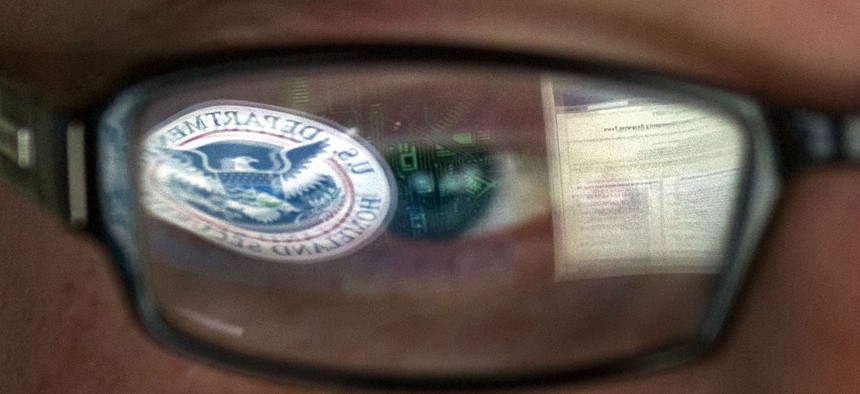How to Boost DHS Cyber Division Morale? Change Its Name.

Mark J. Terrill/AP File Photo
The title -- National Protection and Programs Directorate -- does not jive with the division's purpose, explains Suzanne Spaulding, undersecretary of the ill-named directorate.
Congress late last year elevated the information security mission of the Department of Homeland Security, but that did not do much to elevate the morale of the personnel serving that mission.
Employee satisfaction is dropping more at Homeland Security -- 15 percent since 2010 -- than at any other major federal agency, according to the latest annual Federal Employee Viewpoint survey.
Renaming the department's information security-focused directorate could help adjust employee attitude, says one top DHS official.
The title -- National Protection and Programs Directorate, or NPPD -- does not jibe with the division's purpose, explains Suzanne Spaulding, undersecretary of the ill-named directorate.
"One of the things we're hoping to do is to change our name, and I actually think that while that seems superficial, that will also help improve our morale by aligning our workforce with a clear sense of their identity and that cyber and infrastructure protection is what we're all about," she told lawmakers at a Wednesday House hearing on a reorganization proposal.
Congress would have to christen the directorate with a new title.
“The name is not up to us, but we hope for something that reflects our work in cybersecurity and infrastructure protection," a DHS spokesman said in an email. "NPPD is just ridiculous."
In addition to renaming the division, Spaulding wants to break it into three interlinked directorates.
"We're all part of the same team," she said. "One team. One fight."
The first subdivision, "Infrastructure Security," would concentrate on protecting the nation's key industries from network and physical risks by working with sector businesses, DHS officials testified. This group would subsume the following existing entities: the Office of Emergency Communications, Cyber Security Advisor program, Critical Infrastructure Cyber Community Voluntary Program, Protective Security Advisor program and the Chemical Facility Anti-Terrorism Standards program.
The second subgroup would carry out the department's new congressional mandate to stave off civilian IT and communication systems threats, officials said. Last December, lawmakers approved legislation that cements the home of the nation's 24-hour digital threat-intelligence hub, the National Cybersecurity and Communications Integration Center, inside DHS. Another 2014 law, an upgrade of the 2002 Federal Information Security Management Act, directs the department to oversee cyber operations governmentwide.
The third operational group would represent the existing Federal Protective Service, according to DHS. The service now is paying greater attention to the protection of data security at federal facilities.
The reorganization also would distribute more staff across the country, outside of Washington, where critical industries operate.
DHS officials and the House Homeland Security Committee got into a tiff over the restructuring last month. The panel's Republican and Democratic leaders complained to DHS Secretary Jeh Johnson in a Sept. 15 letter the department failed to loop in the authorizing committee before proceeding with musical chairs.
In a further exhibition of discontent, the full House on Tuesday night passed legislation barring any reorganization without congressional approval.
The press obtained details on the suggested structural makeover too early, Spaulding explained to the panel's Cybersecurity, Infrastructure Protection, and Security Technologies Subcommittee on Wednesday. Most of the changes will require legislative action, she added.
"I understand the committee's frustration that information related to the changes that were under consideration leaked prematurely to the media before we had a plan that the secretary had an opportunity to review, and I could get down here to brief the committee on that plan. This is an ongoing process that continues," Spaulding assured lawmakers.
The employee sentiment scores for NPPD, alone, did go up "slightly" in the survey this year, she noted, albeit, “the numbers are nowhere near where we like them to be or where they ought to be."
At the hearing, a federal auditor cautioned that given the fractured nature of the overall department and poor morale, it is crucial DHS management listen to employees' concerns during the reforms.
"The way the department was formed initially, bringing together 22 different component agencies, all with very different missions and cultures," like the Transportation Security Administration and the U.S. Coast Guard, "created a huge challenge in becoming one," said Chris P. Currie, director of the Emergency Management National Preparedness and Critical Infrastructure Protection Homeland Security and Justice Team at the Government Accountability Office.
At NPPD, workers with the Federal Protective Service, which was added in 2009, serve a completely different duty than employees at the round-the-clock cybersecurity center, he said.
"Part of this reorganization is intended to bring the workforces together under one clear mission," Currie inferred.
NEXT STORY: Name change, new org chart feature in NPPD reorg




